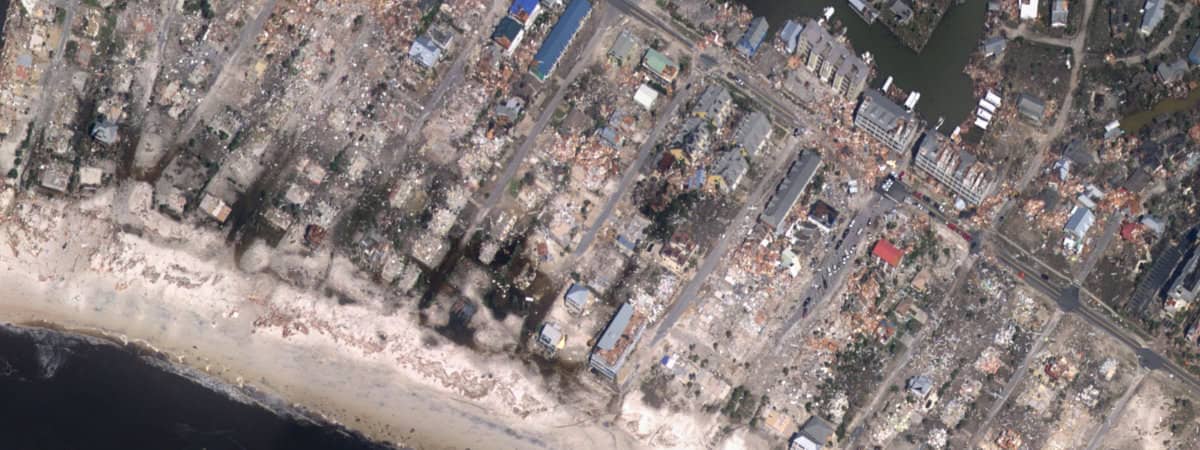Last week, NOS was once again called to service as Hurricane Michael ravaged the Florida Panhandle and portions of Georgia and Virginia. I’m relieved to report that all of our personnel in the affected areas are safe and accounted for. Nonetheless, it has been a hectic and challenging time as many of us have been preparing for, responding to, and beginning to recover from hurricanes for more than four weeks now. Following is an update of our recent activities in support of response and recovery to Hurricanes Michael and Florence.
The National Geodetic Survey (NGS) collected damage-assessment imagery of areas affected by Hurricane Michael identified by NOAA, the Federal Emergency Management Agency (FEMA), and other state and federal interests. Imagery was processed and posted online within approximately four hours of the flights, and may be viewed online via the NGS aerial imagery viewer. NGS began response efforts on October 11, one day after landfall. NOAA’s King Air aircraft, operating from Mobile, AL, collected 9,580 images covering 10,756 square kilometers of the most heavily affected areas. The imagery assessed coastal impacts to navigation and identified landing zones for helicopters to deliver supplies to areas cut off by the storm. NGS thanks the NOAA Gulf of Mexico Disaster Response Center in Mobile, Alabama, and its staff for assistance in staging operations and uploading imagery. The U.S. Coast Guard incident command post also used the imagery to coordinate response efforts. Data is available covering inland areas between Florida’s State Road 20 and Interstate 10; areas north of I-10 and west of Lake Seminole; coastal areas west of Panama City; and inland areas near Apalachicola.
The Office of Coast Survey’s (OCS) latest blog entry notes that NOAA’s western Gulf Coast navigation manager embedded with the Maritime Transportation System Recovery Unit in Mobile, Alabama, to coordinate with the U.S. Army Corps of Engineers (USACE) and the U.S. Coast Guard (USCG) on storm preparations and NOAA’s navigation response team (NRT) activities. Once the storm passed through the Florida Panhandle, NRT-Stennis, MS, and NRT-Fernandina Beach, Florida, surveyed areas in Pensacola and Panama City at the request of USACE and USCG. The teams also searched for the USS Sea Fighter’s two anchors, as well as three range towers for USCG. In addition to surveying, NRT-Fernandina Beach investigated a tide gauge for CO-OPS in Panama City. The data collected from the surveys complements USACE's single-beam survey efforts in federally maintained channels and surrounding areas. OCS is compiling a list of potential dangers to navigation and is working with USCG, USACE, and port partners to ensure these items are either salvaged or submitted to OCS as Dangers to Navigation and then distributed to mariners via NOAA's weekly electronic navigation chart updates.
The Office of Response and Restoration (OR&R) is reviewing early imagery from Hurricane Michael, taken by the National Geodetic Survey (NGS), to identify potential pollution sources such as displaced vessels and containers. The extreme winds and storm surge caused widespread damage, and there are many reports of displaced, overturned, and capsized vessels. The imagery is being ingested into OR&R’s Environmental Response Management Application (ERMA®). NOAA and the U.S. Environmental Protection Agency have identified regulated facilities, including commercial and industrial facilities and Superfund sites, that lie in the affected zones. NOAA’s Gulf of Mexico Disaster Response Center in Mobile, Alabama, is currently providing office space and support to the U.S. Coast Guard and NGS. All OR&R staff working in the areas impacted by Michael are accounted for. OR&R also continues to staff the North Carolina incident command post for pollution task-force operations for Hurricane Florence.
The U.S. Integrated Ocean Observing System (IOOS®) is working closely with its Gulf of Mexico (GCOOS) and southeastern U.S. (SECOORA) regional associations to monitor Michael’s aftermath and assist in response. In-situ observing equipment includes high-frequency radars, buoys, and gliders, which functioned as expected during the storm. All gliders continued to transmit data to the IOOS Glider DAC Map throughout the storm, which passed within 50 kilometers of U.S. Navy glider NG288. Data and information for Michael can be found on SECOORA's Michael Dashboard, and general hurricane resources are available on the IOOS Hurricane Season Resources page. Additionally, as part of a broad IOOS team effort, mid-Atlantic regional association (MARACOOS) partners at Rutgers University posted several blog entries comparing glider observations to model output.
The Office for Coastal Management (OCM) reports no impacts to operations following Hurricane Michael, and all staff are accounted for. Partners at Florida’s Apalachicola National Estuarine Research Reserve reported some damages to facilities, which remain closed. State staff in Florida continue to assess damages to the reserve and nearby aquatic preserves, and are involved in site cleanup and facilities damage assessment. In terms of post-Florence response, OCM provided data used to produce National Hurricane Center storm-surge maps in advance of the storm and technical assistance for other storm-surge forecast products. OCM also helped the Office of Response and Restoration’s disaster response team locate derelict vessels. Digital Coast resources were shared with state partners pre- and post-storm, and office staff and liaisons assisted with communications plans. OCM continues to share relevant information as it becomes available, and will continue to assess and support partners’ operational needs.
The National Centers for Coastal Ocean Science (NCCOS) reports that its Beaufort Lab in North Carolina returned to full operations after experiencing minor water damage and downed trees, and operating on generator power for several days, in the aftermath of Hurricane Florence.
The Office of National Marine Sanctuaries (ONMS) reports that the staffs of Monitor, Gray's Reef, and Florida Keys national marine sanctuaries are safe and accounted for following Hurricane Michael. All offices are open. Monitor and Gray's Reef were closed for one day during the storm.
Nicole R. LeBoeuf
Acting Assistant Administrator
Ocean Services and Coastal Zone Management,
National Ocean Service
 An official website of the United States government.
Here's how you know we're official.
An official website of the United States government.
Here's how you know we're official.
